Fraser Island trails take in Lake Mackenzie and Pile Valley
It’s wise to tread carefully on the world’s largest sand island.
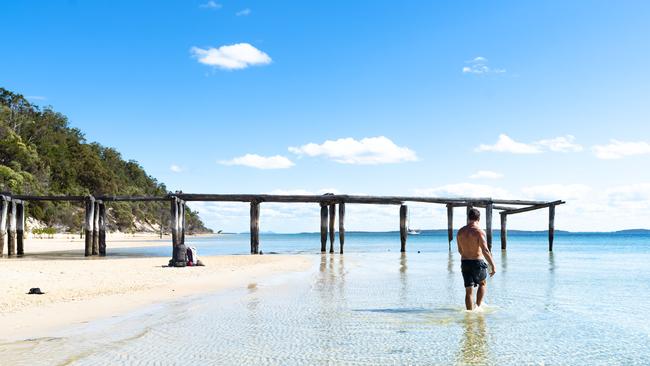
The thing about coming within half a step of planting your foot on a massive carpet python is that evolutionary instincts jump into the driver’s seat before your brain can process the impending collision. Evasive action occurs quickly. Yet the slumbering serpent is unperturbed by the sudden backpedalling of a dozen hiking boots. It lies motionless, soaking up the dappled light filtered through the forest. Composure regained, we slip past and continue our hike, instincts primed like never before.
I had expected surprises on Fraser Island – or K’gari, the Indigenous name it’s officially known by – but the biggest revelation is what the snake is sleeping on. Ironically, it’s the destination’s most obvious feature.
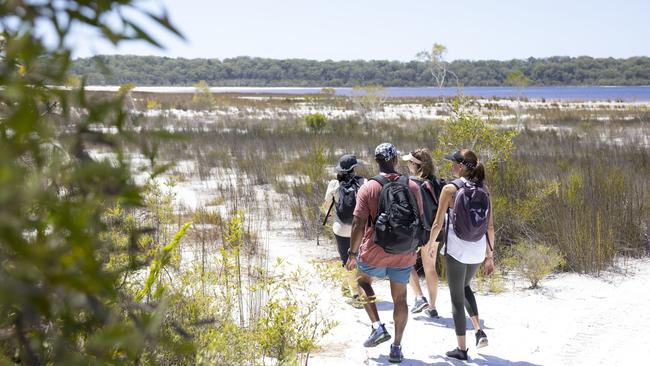
This is, of course, the largest sand island in the world. Every square metre of the 123km long and 22km wide ribbon – from the beaches to the inland hills and every road – is sand. It’s a land without topsoil, without natural grass, without vegetable gardens, without anything that hasn’t evolved to grow out of the nutrient-poor ground.
Geological assumptions are out the window, too. Any child who’s tried to build a moat around a sandcastle knows it will never fill. So how does this giant sandcastle hold half the world’s perched freshwater lakes? And what about the countless capillaries of pristine streams, fed by an inexhaustible supply of fresh water gushing from the world’s largest unconfined aquifer on a sand island?
It’s no surprise the island was awarded UNESCO World Heritage status in 1992 in recognition of these natural wonders, nor that K’gari translates in the local Butchulla language to “Paradise”. It’s certainly a paradise for walking. While ultra-keen hikers can tackle the six-day, 90km Great Walk, pitching tents along the way, most will prefer something less intense.

Fraser Island Hiking offers three ways to walk the island: a self-supported hike that includes vehicle transfers (carry and cook your own food); a pack-free supported hike with tents set up and meals provided (you still need to cook them); or the luxury option I’m doing. Best of the Fraser Island Great Walk is a fully guided hike (or rather a series of day hikes, 7km-15km a day), and is the pick for those who don’t wish to cook, carry or clean. The luxury is in the logistics. Owner Jane Needham has used her local knowledge to curate a masterful itinerary that showcases the absolute highlights over four stress-free days.
Arriving on a barge from River Heads, 20 minutes south of Hervey Bay, we get settled in at Waiuta Retreat, our home for three nights nestled into the hills above Kingfisher Bay. A resident kookaburra presides over breakfast each morning from its perch in a banksia tree, and beyond lies the shimmering blade of Great Sandy Strait. Kitchen gardens don’t exist on sand islands, but our imported meals are exceptional, courtesy of Hervey Bay’s Aquavue restaurant and Maryborough’s MAD Providore, proof that Fraser Coast caterers can match it with the best.
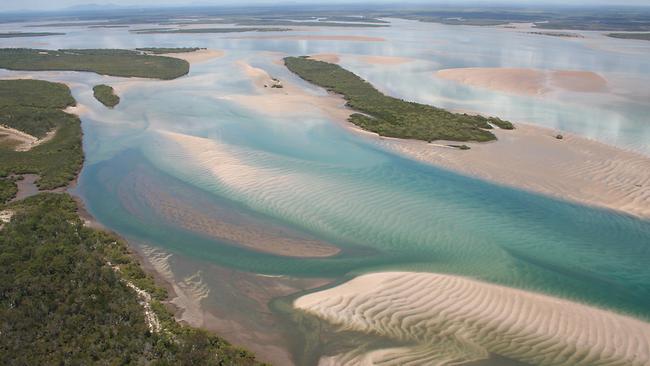
On our first evening we take a sunset walk along the steep west coast dunes of North White Cliffs, dropping down to the historic ruins of McKenzies Jetty, built in 1919 to service the logging industry. The giant satinay trees that were hauled by steam locomotive from the rainforests to this pier were prized for being resistant to marine borer and were used in the construction of the Suez Canal and rebuilding the London Docks after World War II.
It was during that conflict that this tranquil spot became the military base for a secret Allied special forces commando unit to learn boat skills and jungle craft. Remnants of the Fraser Commando School, including concrete foundations, ceramic pipes and possibly a latrine pit, remain scattered in the bush.
We take our shoes off and leave footprints in the corduroy-patterned sand as we stroll back to Kingfisher Bay, past clumps of mangroves and the rusting remains of an old commando school-era boiler. The sinking sun fizzes its last above the horizon and our long shadows scale the coloured cliffs. You couldn’t design a more perfect evening, rounded off by welcome drinks on the wharf and a short drive home to bed.
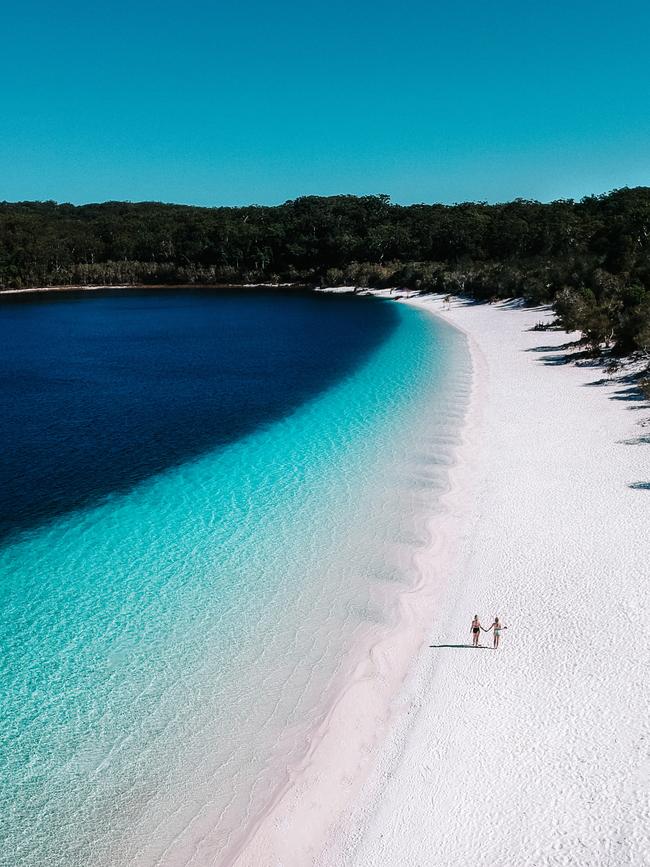
Kingfisher Bay is essentially a gated community, encircled by a dingo-proof fence. It feels like entering Jurassic Park as we cross the threshold and plunge down the rutted sand road into the wilderness of the interior, headed for The Valley of the Giants.
Few people come to this spot, which you can reach only on foot. The temperature drops and the satinays and tallowwoods rise as we weave between fire-blackened eucalypts (the island still bears the scars of last year’s devastating bushfires) and hike into a corridor of rainforest between rolling sand dunes. Satinay trees, native to K’gari and the Cooloola Coast, can grow to more than 40m high and 3m across. The largest are more than 1000 years old. How do they do it, growing out of nothing but sand?
The unlikely success has a lot to do with the symbiotic relationship the roots form with the subterranean fungi, exchanging sugar in return for nutrients. Being free of foxes, the island abounds with digging marsupials such as bandicoots that distribute the fruiting bodies of the fungi. It’s a stark contrast to the mainland, where feral animals have all but eradicated these native “ecosystem engineers”, and another reason this island ark is so precious.
Our final day is all about contrasts. Jane’s husband Ash takes us on a tour of Pile Valley, where piccabeen palms, kauri pine and brush box fill the gaps between the furrowed trunks of the satinays. The former logging settlement of Central Station has been returned to nature, and a gentle track leads along Wanggoolba Creek, nicknamed the Invisible Creek because of how clear the aquifer-fed water is.

The island really is Australia’s lake district, speckled with more than 100 freshwater pools, cupped by forest-fringed dunes and ranging from emerald green to sapphire blue to coral red. We swim in Lake Garawongera, encircled by melaleuca paperbarks, the tannin-stained water amber at the edges, blending to deep red in the middle. Incredibly, there’s not a soul here. It’s a different story at Lake McKenzie, where happy throngs of families spill into the azure water riding inflatable unicorns, or wallow in bliss on the hot, white sand.
On our last night we walk down to Kingfisher Bay jetty, where Jane has organised something special: a lunar eclipse. A green spotlight on a pillar illuminates the water, and fishermen dangle rods into a sea the colour of a radar screen, pulling up squid and dropping them into a bucket. The Milky Way is smeared across the sky and against it rises the shadowy figure of the tannin-red moon, as though Lake Garawongera is reflected in the heavens. It floats above the sand dunes like a portal to paradise.
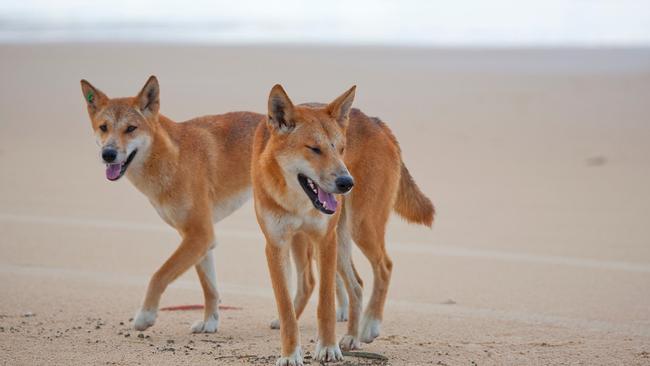
More to the story
Fraser Island is famous for its dingoes, but there are only about 120 on the entire island. For thousands of years the canines lived alongside the Butchulla people as camp dogs. When the locals were dispossessed of their land in the 1800s, the dingoes (those that weren’t killed) were left to fend for themselves. Visitors are forbidden from feeding them, but the dogs remain alert to the prospect of human food and will congregate around camps and picnic areas, kept at bay by fences. I don’t see a dingo during my stay, and I’m not disappointed. I’ll take a carpet python any day.
In the know
Fraser Island Hiking’s Best of the Great Walk runs March-October, departing and finishing at Hervey Bay. $2700 a person including three nights’ accommodation, barge and 4WD transfers, sunset champagne and cheese platter, gourmet meals and wine and beer with dinner. An optional 15-minute scenic flight is $85.
Ricky French was a guest of Tourism and Events Queensland.

To join the conversation, please log in. Don't have an account? Register
Join the conversation, you are commenting as Logout